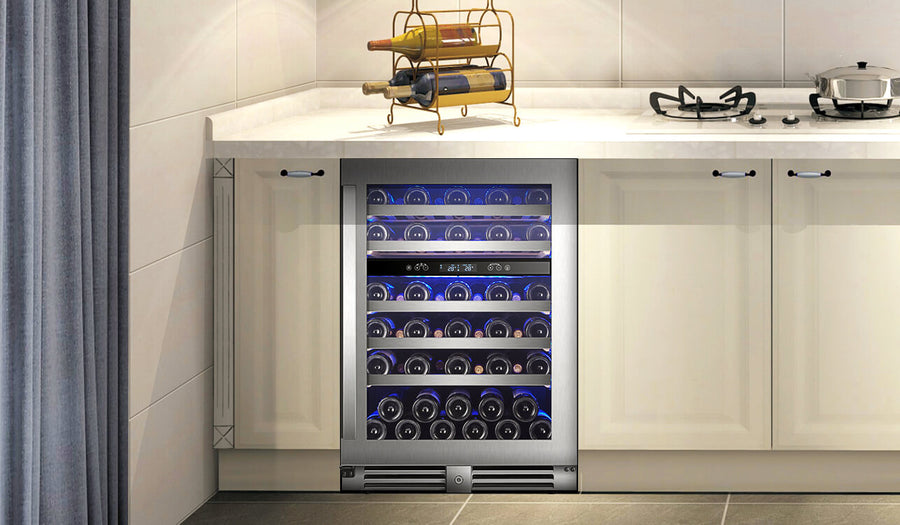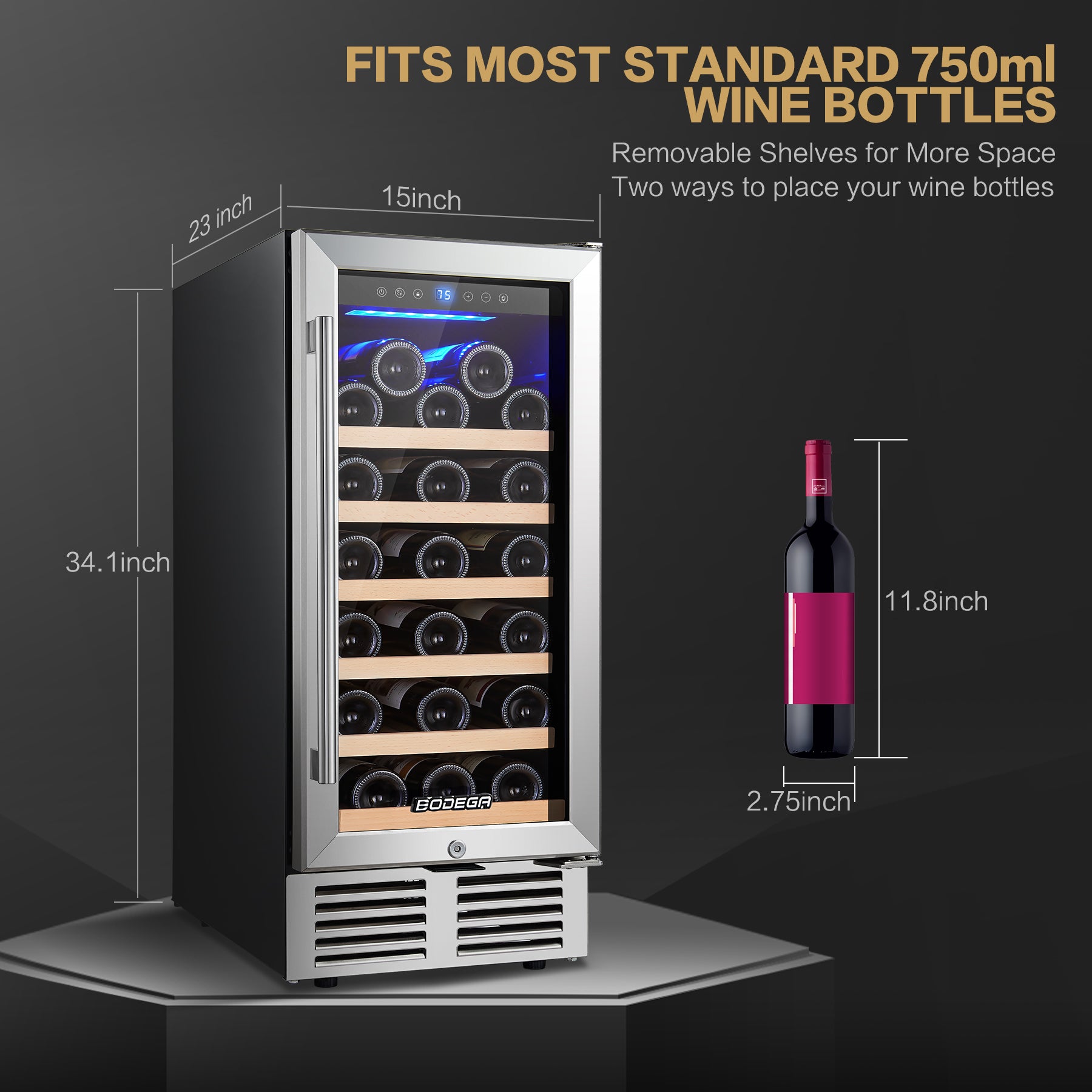With the increasing popularity of wine collecting and appreciation, the demand for effective wine storage solutions is on the rise. Choosing the right wine cooler size is a crucial decision for any wine enthusiast. The battle between freestanding and built-in wine coolers adds an extra layer of complexity to the decision-making process.
Understanding Freestanding Wine Coolers
Definition and Features:
Freestanding wine coolers, standing independently without the need for integration into cabinetry, offer flexibility and convenience. These coolers come in various sizes and designs, catering to diverse preferences. The ability to place them anywhere in your home provides a level of adaptability that resonates with those who seek versatility in their wine storage solutions.
Advantages and Limitations:
The allure of freestanding coolers lies in their versatility. They can be relocated with ease, making them suitable for apartments or homes where a built-in solution is impractical. However, their placement is not seamless and may require a dedicated space.
Size Options and Their Suitability:
Freestanding coolers come in various sizes, catering to different bottle capacities. From compact options suitable for countertop placement to larger units resembling furniture, there's a size for every need.

Understanding Built-in Wine Coolers
Definition and Features:
Built-in wine coolers are designed to seamlessly blend into your kitchen, contributing to a polished and cohesive look. With their streamlined appearance and customization options, these coolers become an intrinsic part of your kitchen's design. They are typically installed during the construction or remodeling of a kitchen, offering a customized and aesthetically pleasing solution. The built-in option is particularly attractive for those who prioritize a unified aesthetic in their living spaces.
Integration with Kitchen Aesthetics:
One of the standout features of built-in coolers is their ability to enhance the overall design of your kitchen. They blend seamlessly with cabinetry, creating a sophisticated and integrated appearance.
Size Considerations for Seamless Installation:
Built-in coolers are available in standard sizes to fit standard cabinet dimensions. However, some models offer customizable dimensions to ensure a perfect fit in your kitchen layout.

Optimal Size for Bottle Capacity
Determining the right size for your wine cooler involves a delicate balance between bottle capacity and available space. While it's tempting to aim for a larger cooler, it's crucial to ensure that it harmonizes with the aesthetics of your home and meets your storage needs.
Consider the number of bottles you currently have and anticipate future additions. If you're a collector in the making, choosing a size that accommodates potential growth ensures a more enduring solution.
Space Efficiency and Design Harmony
Utilizing Space Efficiently with Freestanding Coolers:
Freestanding coolers, with their varied size options, allow you to choose a unit that maximizes available space. From compact designs suitable for tight corners to larger units that make a statement, freestanding coolers offer versatility in space utilization.
Achieving a Cohesive Kitchen Design with Built-in Coolers:
Built-in coolers take a different approach, seamlessly blending with your kitchen's aesthetic. Their standardized sizes ensure a harmonious integration, contributing to a polished and cohesive design.
User Experience and Accessibility
Convenience of Access in Different Size Scenarios:
The user experience varies with the size of your wine cooler. Freestanding coolers, with their standalone nature, offer easy access from all sides. On the other hand, built-in coolers may have doors that open in a specific direction, influencing accessibility.
User-Friendly Features Influencing Size Choice:
Consider the features that enhance user experience when choosing the size of your wine cooler. Factors such as adjustable shelves, digital controls, and interior lighting can contribute to the overall convenience of use, regardless of the cooler's size.
Cost Considerations
When it comes to wine coolers, size can have a direct impact on cost. Larger coolers with advanced features often come with a higher price tag. However, it's essential to evaluate the long-term value of your investment.
Consider the initial cost against the potential need for an upgrade in the future. Opting for a slightly larger cooler than your current needs dictate can be a cost-effective strategy if you anticipate expanding your collection.

Energy Efficiency and Maintenance
Energy Considerations for Different Sizes: The size of a wine cooler can influence its energy efficiency. Larger coolers may consume more energy to maintain lower temperatures. It's advisable to check the energy efficiency ratings of different sizes to choose an environmentally friendly option.
Maintenance Requirements Based on Size: Maintenance is a crucial aspect of preserving your wine collection. Larger coolers may have more components, necessitating more extensive maintenance. Consider your willingness and ability to perform regular upkeep when choosing the size of your wine cooler.

See more: How to Choose the Perfect Wine Cooler for Your Collection🎅🏻
Conclusion
Whether you opt for the flexibility of a freestanding cooler or the seamless integration of a built-in counterpart, the key lies in making an informed decision that aligns with your present and future needs.
FAQs
Q: Is a larger wine cooler always better?
- A: Not necessarily. Choose a size that accommodates your current collection and allows for future growth without sacrificing space efficiency.
Q: Can I use a freestanding cooler as a built-in and vice versa?
- A: While some coolers are versatile, it's recommended to follow the manufacturer's guidelines to ensure proper ventilation and performance.
Q: Do built-in coolers come in standard sizes?
- A: Yes, many built-in coolers offer standard sizes, but there are also options for customizable dimensions to fit specific spaces.
Q: What's the ideal space around a wine cooler for ventilation?
- A: Typically, leave at least 2–3 inches on each side and 4–6 inches at the back for proper ventilation, but refer to the manufacturer's recommendations.
Q: Can a smaller wine cooler be as efficient as a larger one?
- A: Yes, if it meets your storage needs. The efficiency of a wine cooler is not solely determined by its size but also by its design and features.







